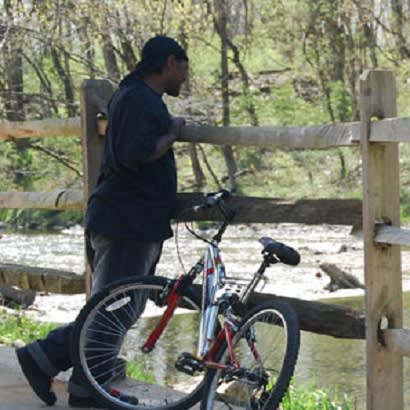
Using CDC’s park access measures, Five Rivers MetroParks of Dayton, Ohio evaluated access to its Five Rivers MetroParks for residents within a half mile radius of the parks. This method included looking at proximity to parks, walking access to parks, and park connectivity. In addition, MetroParks looked into the prevalence of real and perceived crime around its parks as part of a health community impact assessment for their county public health department with the help of Wright State University and the City of Dayton Police. All of this data was used as part of a Safe Routes to Parks initiative regarding Wesleyan Park and in partnership with their metropolitan planning organization, the Miami Valley Regional Planning Commission.
Identifying Neighborhoods of Focus
The National Environmental Public Health Tracking Network was used to see what percent of people in their county had a half-mile access to parks. Five Rivers MetroParks’ park data and Miami Valley Regional Planning data was used to determine what amount of their county’s population lived in a half-mile radius of Five Rivers MetroParks. From this population, entry point information was used to determine what percentage of those living in a half-mile radius had less than a half-mile walking route to the park. This percentage defined the park’s connectivity network. Using this data, 25 additional park entrances were identified by their potential to have the greatest impact on expanding their respective park’s connectivity network.
Mapping Connectivity
The existing and projected networks of populations within a half-mile walk to a park entrance were overlaid on a map to show current connectivity and the impact of adding the proposed park entrances. Working with the Miami Valley Regional Planning Commission, areas with high stress road barriers and low stress connections to Miami Valley Trails were also mapped out to elucidate areas that needed improvement around Five Rivers MetroParks.
Using Crime Data
Through Wright State University, the Miami Valley Regional Planning Commission worked with graduate program students who created a research report on crime prevention methods and crime in all of Dayton. The crime data was provided by the City of Dayton Police and MetroParks Rangers and was mapped for a 50-foot buffer around each park. Some of the statistics analyzed included park crime count, location quotient analysis, and crimes per acre. These statistics were used to determine which parks had the highest crime rates and thus, were in greatest need of safety improvements. In particular, it was found that Wesleyan Park had the highest crime rate of all the Five Rivers MetroParks, and this confirmed its priority as a site of the Safe Routes to Parks initiative. In addition, the results showed that parks had lower rates of crimes in comparison to the rest of the city. In the fall of 2017, another report will be done concerning the perception of safety around each park.
